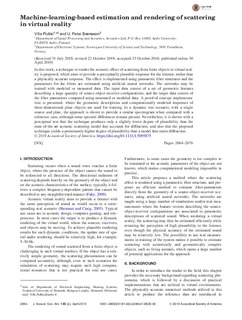| dc.contributor.author | Pulkki, Ville | |
| dc.contributor.author | Svensson, U. Peter | |
| dc.date.accessioned | 2019-11-28T07:14:16Z | |
| dc.date.available | 2019-11-28T07:14:16Z | |
| dc.date.created | 2019-07-02T12:32:38Z | |
| dc.date.issued | 2019 | |
| dc.identifier.citation | Journal of the Acoustical Society of America. 2019, 145 (4), 2664-2676. | nb_NO |
| dc.identifier.issn | 0001-4966 | |
| dc.identifier.uri | http://hdl.handle.net/11250/2630809 | |
| dc.description.abstract | In this work, a technique to render the acoustic effect of scattering from finite objects in virtual reality is proposed, which aims to provide a perceptually plausible response for the listener, rather than a physically accurate response. The effect is implemented using parametric filter structures and the parameters for the filters are estimated using artificial neural networks. The networks may be trained with modeled or measured data. The input data consist of a set of geometric features describing a large quantity of source-object-receiver configurations, and the target data consist of the filter parameters computed using measured or modeled data. A proof-of-concept implementation is presented, where the geometric descriptions and computationally modeled responses of three-dimensional plate objects are used for training. In a dynamic test scenario, with a single source and plate, the approach is shown to provide a similar spectrogram when compared with a reference case, although some spectral differences remain present. Nevertheless, it is shown with a perceptual test that the technique produces only a slightly lower degree of plausibility than the state-of-the-art acoustic scattering model that accounts for diffraction, and also that the proposed technique yields a prominently higher degree of plausibility than a model that omits diffraction. | nb_NO |
| dc.language.iso | eng | nb_NO |
| dc.publisher | Acoustical Society of America | nb_NO |
| dc.title | Machine-learning-based estimation and rendering of scattering in virtual reality | nb_NO |
| dc.type | Journal article | nb_NO |
| dc.type | Peer reviewed | nb_NO |
| dc.description.version | publishedVersion | nb_NO |
| dc.source.pagenumber | 2664-2676 | nb_NO |
| dc.source.volume | 145 | nb_NO |
| dc.source.journal | Journal of the Acoustical Society of America | nb_NO |
| dc.source.issue | 4 | nb_NO |
| dc.identifier.doi | 10.1121/1.5095875 | |
| dc.identifier.cristin | 1709328 | |
| dc.description.localcode | © 2019 Acoustical Society of America.. This article may be downloaded for personal use only. Any other use requires prior permission of the author and the Acoustical Society of America. The following article appeared in The Journal of the Acoustical Society of America 145, 2664 (2019); https://doi.org/10.1121/1.5095875 | nb_NO |
| cristin.unitcode | 194,63,35,0 | |
| cristin.unitname | Institutt for elektroniske systemer | |
| cristin.ispublished | true | |
| cristin.fulltext | original | |
| cristin.qualitycode | 2 | |
